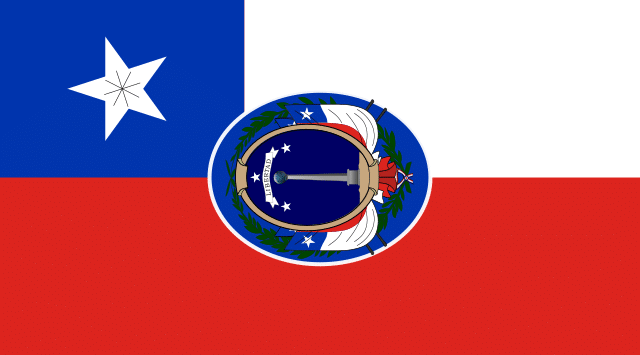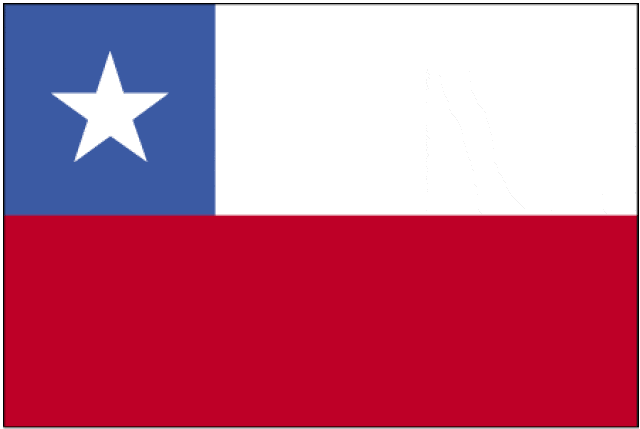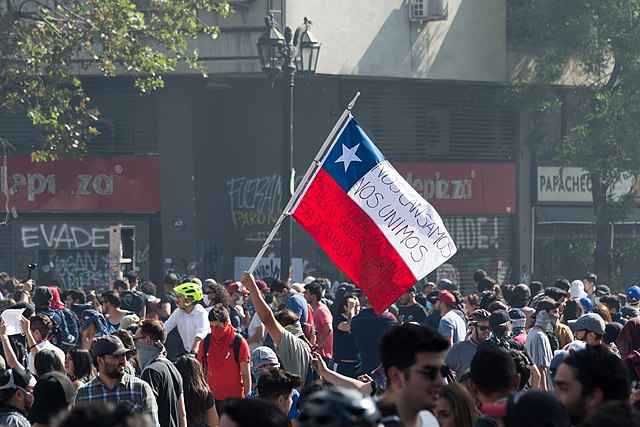The Chile flag is a powerful and iconic symbol of the country’s rich history and national identity. It was approved on October 18, 1817, and since then it has been an official representative of the country. The flag represents heroic bravery, blood, the blue sky, and the Andes mountains. The white star is interpreted in one way to signify honor and the development of the country and once again expresses that Chile is a centralized state rather than a federated one.
If you want to know more about the Chile flag, then we’re about to explore its history, significance, and symbolism.
Geography Of Chile
In order to deeply understand the symbolism of the Chile flag, it is important to discuss the country’s geographical location. Chile is a long, thin nation that stretches like a ribbon down South America’s west coast. Despite being almost 4,000 miles long, the shoreline is just 61 miles broad.
Cape Horn is where South America’s southernmost tip is located. Before the Panama Canal was created, ships had to round the Horn to get from the Pacific to the Atlantic ports and to Europe. High winds and dangerous surf are characteristic of Cape Horn.
There are three different zones of time in Chile. While the Magallanes and Chilean Antarctica regions utilize UTC-03:00 year-round, the majority of continental Chile observes UTC-04:00 in the winter and UTC-03:00 in the summer.
Today, native Mapuche and other indigenous communities make up just around 5% of the population. The roots of over 95% of Chileans are both indigenous and European. The Mapuche people dwell in parts of the south, where they have their own religion and speak their own language. The region around Santiago, the country’s capital, is home to about 40% of the population.
In Chile, the head of state and the head of the executive branch are the same people: the president. The cabinet is picked by the president. The two houses of Congress are the National Congress and the Senate.

A Brief History of Chile
The history of Chile and Chile’s flag development are intertwined. Therefore, before discussing the characteristics of the flag, it is essential to briefly look at the country’s history. The northern part of the nation was ruled by the Inca before the Spanish arrived in the 16th century.
A while before Chile became a Spanish colony, the southern and central areas were inhabited by native Mapuche people.
The country proclaimed its independence from Spain in 1810. German, French, British, and Italian settlers started arriving in Chile around the end of the 1800s. Many Chinese immigrated to Chile in order to help with the railroad’s construction.
In the past, Chile was seen as a fairly free and stable country. However, Salvador Allende’s elected Marxist administration was overthrown in a brutal conflict in 1973, and the nation suffered under Gen. Augusto Pinochet’s dictatorship, which lasted for 16 years. In 1989, democracy was reinstated in the country.
History Of Chile Flag
First Chile Flag
Indigenous peoples may have first used flags during the War of Arauco. The most famous example of this is the use mentioned in the late 16th-century epic poem La Araucana. There are records of two flags being used by Mapuche soldiers. These accounts, however, were written at the end of the eighteenth century, and their exact age is unknown.
One had a white star with five points on a blue backdrop, like the canton of the present Chilean flag, while the other included an eight-pointed white star in the middle of a blue diamond with a zigzag border over a black background. The most famous artistic depiction of the later flag was made by painter Pedro Subercaseaux, who depicts chief Lautaro waving it.
The conquering forces flew numerous different Spanish flags. Each battalion had its own flag, which could have a variety of designs, including the heraldic coat of arms of the King of Spain. The Cross of Burgundy, a ragged, crimson saltire crossed on a white fabric, was one of the most frequently utilized emblems.
During the Spanish colonization of the Americas, the Cross of Burgundy, one of the primary emblems of the Spanish Empire abroad, was flown over the warships and carried by the militia in the colonial territory.
The Arauco War, a long-running war between the Spanish and the Mapuche that began with the early Spanish invasion in the 1500s and ended decades after Chilean independence, lasted for centuries. As they fought for control of territory in Chile, tens of thousands of people perished on either side.

“Flag Of Transition”
In the Temuco area of northern Chile, on May 26, 1817, Bernardo O’Higgins and Jose de San Martin defeated the Spanish occupation forces. After winning, Chile created a second national flag. The name of this new flag was “Liberation.” Red was used in place of the flag’s original yellow hue to represent the rebels’ blood. White represented the snow on the Andes, while blue represented the Pacific Ocean. Juan Gregorio de Las Heras created that Chile flag.
Due to the New Salvation Flag’s resemblance to the French flag, people often confuse the two nations. Thus, on October 18, 1817, the flag was replaced with the addition of a star after just five months. Two horizontal red and white bars of equal width made up that flag. A blue square with a white five-pointed star inside it was seen on the left side of the white strip.
The great ocean and blue sky are represented by the starlight and glowing route. The red and white colors stand for the bloodshed for the sake of freedom, while the white hue represents the snow in the Andes.

Current Chile Flag
Bernardo O’Higgins served as the Liberating Process’s leader during Chile’s 1818 uprising. The Spanish military left Chile in full force in 1826. The first national anthem for Chile has been commissioned by the government. The first anthem’s text and musical structure were decided upon on August 20, 1820. This first hymn was written by Manuel Robles, who also served as the poet.
The war between Chile and its neighbors Bolivia and Peru broke out between 1879 and 1883. It advanced north as a result of these battles, expanding its territory by one-third and annexing the Atacama region. Bolivia’s vast ocean carved a path for it and hastened its growth and development. General Augusto Pinochet launched a coup and established military rule as his dictatorship in 1973.
Patricio Aylwin was elected president in 1989 when Chile re-established its democratic government. Despite the ups and downs the Chilean people have experienced, the current national flag has remained constant since then.

Symbolism Of Chile Flag
As for the Chile flag’s symbolism, the white has historically represented the snow of the Andes Mountains. The blue color represents the sky. The crimson is a reminder of the blood lost by early Chileans during their battle for their country’s freedom from Spain.
The lone star’s presence may have been influenced by a variety of factors. Some claim that it draws attention to Chile’s unitary status. Others claim it represents a path toward honor and advancement. Most intriguing, early depictions of a flag flown by indigenous Mapuche forces during the Arauco War portray a blue and white star-topped banner, which is almost exactly like the blue portion of the current Chile flag.

Chile Flag Characteristics
Chile’s flag is among those that can be flown horizontally. However, the blue square and white star must still be visible in the upper left corner in any case. Americans may mistake Chile’s flag for Texas’ flag with ease. The main distinction is that Texas’ blue square extends to the bottom when flown horizontally rather than merely to the white band’s bottom.
Their resemblance is likely a coincidence given that flags from all around the world, including those from Cuba and Liberia, have the star and stripe design and colors. Each of these flags’ stars and colors stands for a unique element of cultural and historical value.
Chilean legislation establishes stringent regulations for the usage and display of the national flag. On several national holidays, the flag must be flown from homes and structures. A fee might be assessed if this isn’t done. The legislation prohibited the display of the flag in public without official permission on days other than the festivals that called for it to be shown as recently as October 2011. The legislation also classifies public abuse of the flag as a crime.
On military posts all around Chile, the commitment to the Chile flag is read on July 10 each year to remember the 77 troops who sacrificed their lives in the Pacific War battle of La Conception in 1882. In the pledge, participants swear to uphold honorable principles like serving and obeying orders promptly and without fail, wherever they may be.
Bottom Line
To sum up, the original Chile flag, which was flown during the relentless struggle for independence from the Spanish empire, was very different from the one flown today. The Chile flag was required by federal law to be flown on all residences and establishments on specific annual occasions. The current Chile flag is very similar to the banner flown by the Mapuche people, who originally lived in the region.